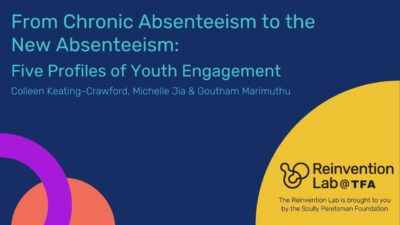
Editor’s Note: This brief was originally published by the North Carolina Early Childhood Foundation. The original version includes an appendix with additional information on individual schools improving attendance.
There are many news stories about the chronic absenteeism problem. Absenteeism rates skyrocketed during the first full school year after the start of the pandemic, and there has been little improvement five years later. However, attention on what is not working may be causing us to overlook schools that are getting it right. Looking at average absenteeism rates across the state, it continues to be clear that they have not recovered. However, there are pockets of good news as some schools, including a handful of high-poverty schools, have figured out how to improve attendance rates.
As many have reported, too many children nationwide, including those in North Carolina, are missing too many days of school. The Department of Public Instruction’s latest attendance data release indicates that for the 2023-24 school year, chronic absenteeism among elementary school students averaged approximately 1.8 times higher than the year before the pandemic.
![]() Sign up for the EdDaily to start each weekday with the top education news.
Sign up for the EdDaily to start each weekday with the top education news.
An average of 23% of students in elementary schools were chronically absent during the 2023-24 school year, compared to 12% during the 2018-19 school year, shown in Figure 1 below. This means that during the 2023-24 school year, approximately 183,000 students in kindergarten through sixth grade were at risk for poor educational outcomes because, as research shows, chronically absent students are at a higher risk of falling behind, scoring lower on standardized tests, and dropping out of school.
To find the good news, we looked at the bottom of the distribution and found that 214 out of 1,306 elementary schools have low chronic absenteeism rates. Even more encouraging is that 15 schools with low rates are high-poverty schools. One such school is Trent Park Elementary, a school of about 350 students located in New Bern. During the 2023-24 school year, 69% of students were economically disadvantaged, and only 9% were chronically absent, down from a high of 23% during the 2020-21 school year.
We won’t spend much time on the bad news, except to remind ourselves of the significance and urgency of the problem. It is essential to begin identifying and learning from schools that are turning the tide and bringing down chronic absenteeism.
Figure 2 below compares the 2023-24 school year to the previous six years, and shows that North Carolina schools mirror the general trend reported nationwide: Chronic absenteeism spiked in the school year immediately after the start of the pandemic and has not returned to pre-pandemic levels. The stubbornness of this rise indicates that it will take consistent effort to reduce chronic absenteeism to pre-pandemic levels.
The good news
Figure 2 above also holds good news. Even though chronic absenteeism continues to be significantly higher than before the pandemic, North Carolina is making progress in bringing chronically absent students back into the building. The 2023-24 rate is seven percentage points lower than the pandemic high of 30% during the 2021-22 school year.
Finding and highlighting the good news in the midst of much bad is a necessary move away from thinking that there is a quick fix and moving toward investing in a comprehensive set of incremental and sustainable improvements. Many strategies are listed in our toolkit, “Actionable Strategies for Increasing Attendance and Reducing Chronic Absenteeism.”
This intentional search for the good-news needles in the haystack revealed that some schools have figured out how to bring students and families back, and — even more exciting — some schools have figured out how to do this with economically disadvantaged students. We identified elementary schools with chronic absenteeism rates at or below the statewide pre-pandemic average of 14%.
Figure 3.1 below shows the 2023-24 chronic absenteeism rates for 1,306 elementary schools across the state. This figure clearly shows that as the percentage of economically-disadvantaged students increases, the chronic absenteeism rate also increases.
Figure 3.2 below, which highlights the 123 low-poverty schools with low absenteeism, shows that, as expected, the lowest poverty schools have the highest attendance rates. Low-poverty schools are those with fewer than 35% economically-disadvantaged students.
Figure 3.3 below, which includes the addition of highlights for the 76 moderate-poverty schools with low absenteeism, shows that as the poverty rate increases, there is a greater need for programs that foster strong attendance. Moderate-poverty schools are those with between 36% and 60% economically-disadvantaged students.
Figure 3.4 below, which includes the addition of highlights for the 15 high-poverty schools with low absenteeism, shows that there are high-poverty schools that go against the high-absenteeism trend. High-poverty schools are those with more than 61% economically-disadvantaged students.
More good news
Next, we examined the seven-year trend in chronic absenteeism from the 2017-18 to the 2023-24 school year. The data revealed a few patterns among schools that are turning the tide and have reduced their chronic absenteeism spike. These schools are the needles in the haystack that can potentially provide local North Carolina solutions that other schools can implement. A small number of elementary schools were able to rebound immediately during the 2021-22 year; others took two to three years before seeing substantial improvements.
Examining each school’s trend revealed that 149 schools have reduced their chronic absenteeism spike to a rate that is less than or equal to 1.25 times their pre-pandemic rate. See the interactive display of Figures 4.1 to 4.5 below.
- Ten schools lowered their rates quickly during the 2021-22 school year.
These schools tended to have absenteeism that was higher than the statewide average before the pandemic (averaged 18% during the 2018-19 school year), spiked to 26% during the 2020-21 school year, and were back down to 18% by the end of the 2021-22 school year. These schools are below the current statewide average, but still have room for improvement before attendance is no longer a priority issue. - Thirty-five schools took two years to return to their pre-pandemic level.
These schools tended to have high absenteeism before the pandemic (averaging 21% during the 2018-19 school year), had two years of increasing absenteeism after the pandemic, and reached an average of 34% during the 2021-22 school year. They began recovering attendance during the 2022-23 school year and had reduced it to an average of 21% by the end of the 2023-24 school year. Although these schools have, on average, returned to their pre-pandemic levels, there is still much room for improvement. - One hundred and four schools took three years to return to their pre-pandemic levels.
These schools tended to have absenteeism that matched the statewide average before the pandemic (averaging 15% during the 2018-19 school year), had two years of increasing absenteeism after the pandemic, and peaked at an average of 27% during the 2021-22 school year. They have shown two years of consistent recovery and were down to an average of 17% during the 2023-24 school year. These schools are below the current statewide average, but they still have room for improvement in attendance.
The set of interactive figures below shows the trends for these categories of schools. Note that these figures don’t show the trends for 1,094 schools with absenteeism rates that are higher than their pre-pandemic rates, 10 schools that did not experience a spike in absenteeism, and 54 schools for which 2018-19 data is missing.
Crafting North Carolina solutions
We have highlighted some of the “good news schools;” now the task is to learn more about what is working in these schools and how it can be used to create a North Carolina attendance recovery playbook that could be implemented statewide. Actionable strategies can be identified by looking at and learning from schools that experienced a spike in absenteeism and have figured out how to reconnect with and reengage families.
The path forward will not be found by focusing on what schools with high absenteeism are doing wrong, but on what schools that are showing improvements are doing right.
Recommended reading



